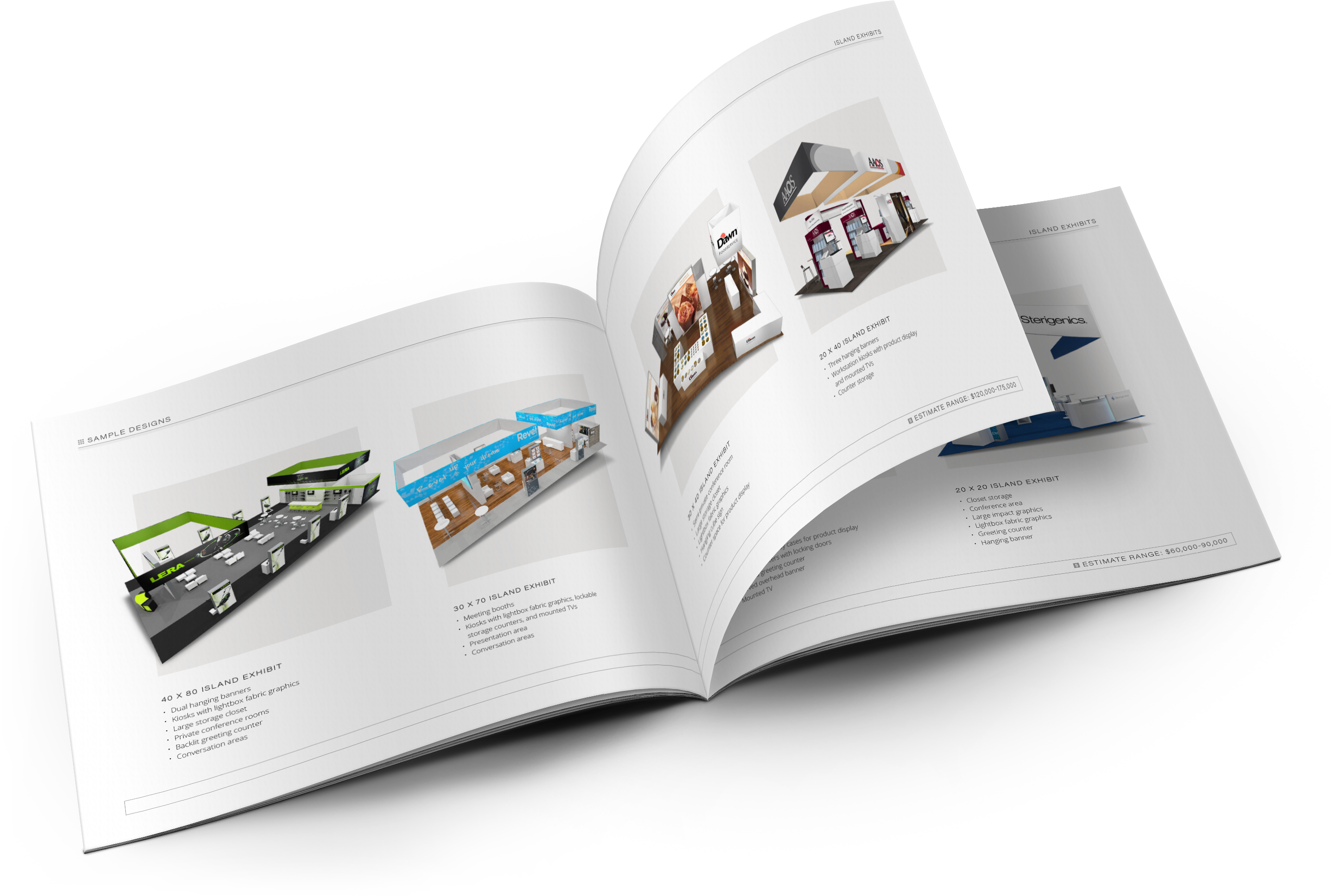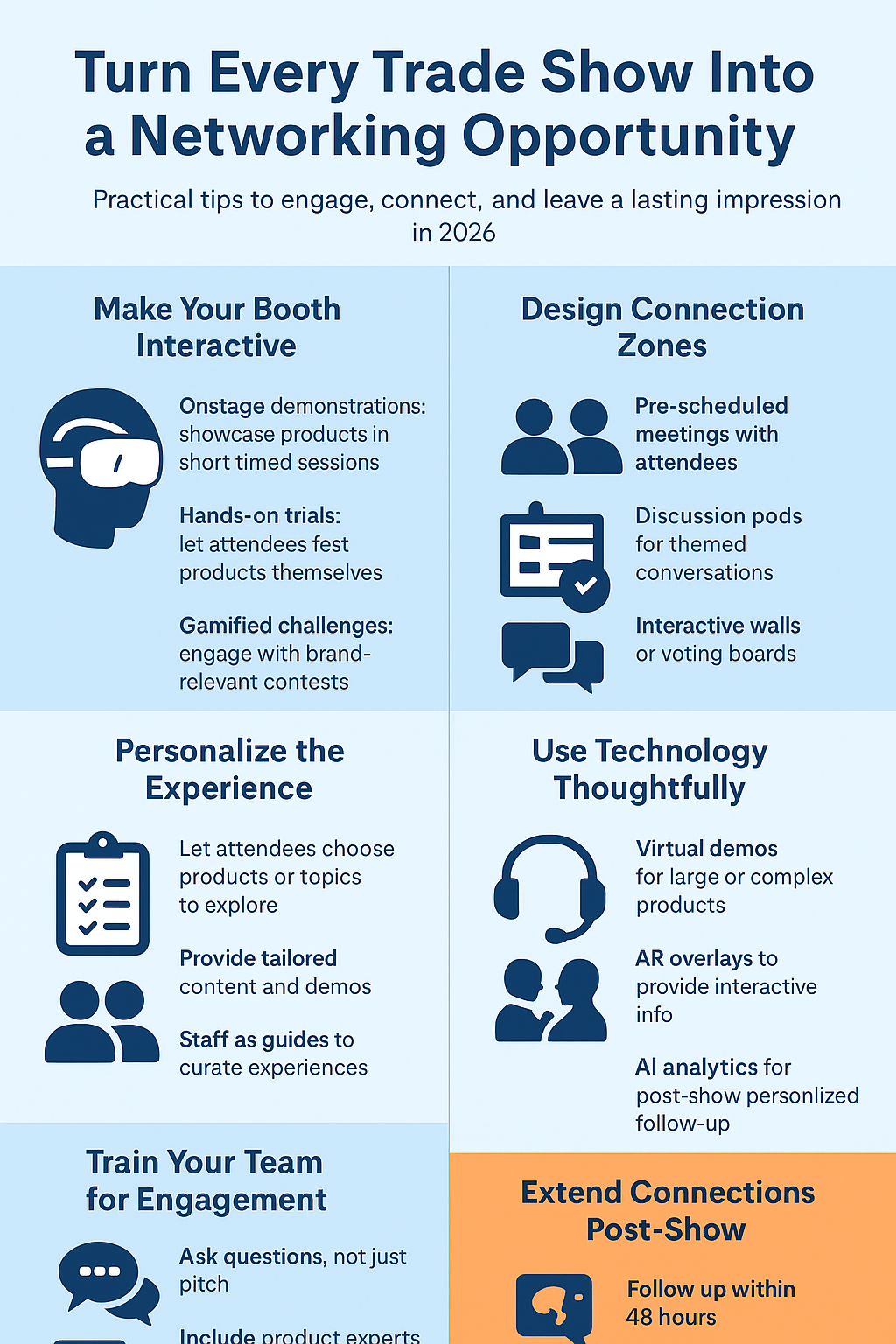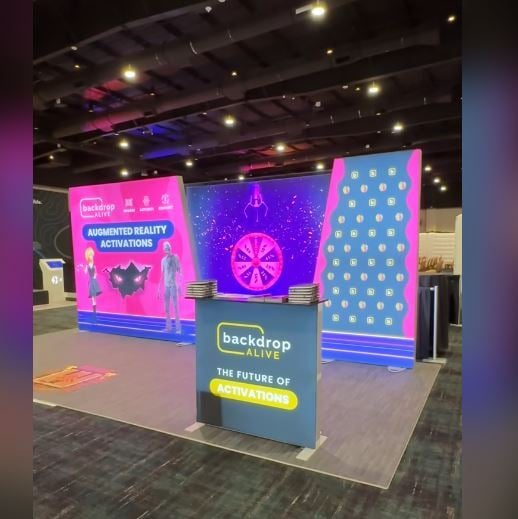Businesses employ promotional strategies to inform customers about their products or services, aiming to generate interest and prompt action - especially at a trade show event. These strategies help distinguish a product, enhance visibility, and engage potential customers in a competitive market. The primary objectives of promotion are to increase awareness, enhance engagement, and drive conversions. Awareness ensures customers recognize the brand, engagement maintains their interest, and conversion transforms their interest into sales. A thoughtfully designed promotional strategy is crucial for businesses of any size, as it aligns marketing initiatives with business goals, optimizes return on investment, and supports customer loyalty. Successful promotion fosters long-term growth and sustains competitiveness.
A well-executed promotional strategy is key to driving business success. By choosing the right strategies, businesses can effectively reach their target audience, increase brand visibility, and boost sales. Here is the list of top promotion strategies a business can follow:
Conventional Marketing Techniques
Traditional promotion strategies have been essential in boosting businesses’ communication with their target audiences. This method focuses on reaching customers through established media channels and face-to-face interactions, offering broad and impactful engagement. Here is the explanation:a. Print Advertising
Newspapers, magazines, and billboards help businesses to reach specific demographic groups. These platforms provide tangible materials that people can engage with in their daily routines. A billboard, for example, captures attention quickly and makes a lasting impression on passersby, while magazines offer targeted advertising that aligns with the reader’s interests.b. Television and Radio Ads
These ads bring brands directly into the homes and lives of potential customers. TV ads, with their visual and auditory elements, can create a dynamic experience that resonates with viewers. They are particularly effective for building brand awareness on a large scale. Radio, on the other hand, helps reach audiences during commutes, work, or daily activities, giving businesses access to potential customers through repetition and strategic placement.c. Direct Mail Campaigns
Sending brochures, catalogs, or promotional materials directly to homes can help establish a tangible connection between the businesses and its audience. This strategy can provide a more intimate touch, allowing companies to target specific customer groups with tailored offers or updates.d. Event Sponsorships and In-person Marketing
This promotion strategy creates opportunities for direct engagement. Sponsoring events like sports, festivals, or charity functions puts a brand in front of active participants, increasing visibility in a relevant context. In-person marketing through trade shows or promotional booths foster one-on-one interaction, helping businesses build personal relationships with potential customers while showcasing their products or services.Online Marketing Approaches
Digital promotion strategies are essential for businesses aiming to reach and engage their target audience in the online world. Each strategy offers unique advantages and, when used effectively, can significantly boost brand visibility and customer engagement, as explained below:
a. Social Media Marketing
This involves promoting products or services through platforms like Facebook, Instagram, LinkedIn, and Twitter. Businesses can target specific demographics based on factors like age, interests, and location, enhancing the precision of campaigns. Social media offers organic and paid strategies. Organic posts can focus on building community engagement through consistent content, while paid ads help businesses reach a broader audience with measurable results.
b. Content Marketing
It helps businesses focus on creating valuable, relevant content to attract and engage a target audience. Blogging is a popular form of content marketing, helping businesses to demonstrate expertise, provide helpful information, and boost SEO rankings.
c. Email Marketing
This type of marketing is one of the most effective digital marketing channels. By segmenting email lists based on customer preferences, behavior, or demographics, businesses can send personalized and relevant messages to each group. Automation can further enhance email marketing, enabling businesses to send timely and consistent communications without manual intervention. Personalized messaging, such as addressing the recipient by name or offering tailored product recommendations, increases engagement and conversion rates. When done right, email marketing helps nurture leads, drives repeat business, and strengthens customer relationships.
d. Search Engine Marketing
SEM is another important component of digital promotion. It consists of Search Engine Optimization (SEO) and Pay-Per-Click (PPC) advertising. SEO focuses on optimizing website content to improve its ranking in search engine results, driving organic traffic. This involves keyword research, optimizing meta tags, and ensuring the site offers a seamless user experience. PPC advertising, on the other hand, involves paying for ads that appear on search engine results pages when users search for specific keywords. Businesses only pay when someone clicks on the ad, making it a cost-effective way to drive targeted traffic effectively.
Selecting the Appropriate Promotion Channels
Choosing the right promotion channels is crucial for a successful marketing strategy. It involves carefully evaluating several factors to ensure you reach your target audience effectively while maximizing your return on investment (ROI), as explained below:
a. Identifying Your Target Audience
The first step is identifying your target audience. Knowing who your ideal customers are helps you to tailor your promotional efforts to their needs, interests, and habits. This further helps you focus your resources on reaching the right people rather than casting a wide, less effective net. Consider demographic factors like age, location, income, and preferences, and psychographic aspects such as interests and values. A well-defined audience is important for any successful promotion strategy.
b. Understanding Customer Behavior and Preferences
Once you have identified your audience, it is essential to understand their behavior and preferences. Are they more active on social media, do they prefer email newsletters, or do they respond better to in-store promotions? Analyzing these behaviors will help you select the most appropriate channels. Digital tools like Google Analytics, social media insights, and customer feedback can help with valuable data about how your audience interacts with different platforms and what content resonates with them.
c. Budget Considerations and ROI Expectations
Every promotion channel requires an investment, whether in time, money, or both. Balancing your budget while setting realistic ROI expectations is key. Digital channels like social media, search engines, and email marketing often offer a lower cost with higher targeting capabilities, while traditional channels like TV or radio might require a larger investment. It is important to analyze the cost-effectiveness of each channel and choose those that provide the best ROI based on your goals and budget.
d. Aligning Promotion Channels with Business Goals
Finally, ensure that your chosen promotion channels align with your business goals. If your goal is to increase brand awareness, channels with a broad reach like social media or influencer partnerships might be best. For driving direct sales, email campaigns or paid search ads could be more effective. The right channels can support your overall marketing objectives, helping you achieve sustainable growth and greater customer engagement.
Creating Engaging Promotional Content
Crafting compelling promotional content is essential for capturing your audience’s attention and driving results. Your messaging should convey the value of your product or service and resonate emotionally with your audience. Storytelling helps bring this message to life, turning your brand into a relatable narrative. This engages customers on a deeper level, making your promotion memorable and impactful.
To create engaging visual and written content, follow these key tips:
a. Keep messaging clear and concise: Focus on the core benefits of your product or service.
b. Use visuals that enhance your message: Incorporate bold colors, striking imagery, and simple, intuitive design for greater appeal.
c. Reflect your brand’s personality: Choose language that aligns with your brand’s voice while resonating with your audience.
d. Speak directly to your audience’s needs: Address their needs and challenges in your content.
e. Prioritize authenticity in writing: Build trust with genuine, relatable messaging to capture attention and foster engagement.
Customer-generated content (CGC) and testimonials are highly effective for promotional success. CGC, including customer reviews or social media posts, enhances your brand's credibility and provides social proof. It showcases real-world application and satisfaction, significantly impacting potential buyers.
Utilizing Influencers and Collaborations
Leveraging influencers and partnerships is a powerful strategy to expand your brand’s reach and engage new audiences. Influencer marketing helps businesses to tap into the loyal following of influencers who align with their brand values. By promoting products through trusted voices, businesses can help reach new demographics, boost brand awareness, and drive higher engagement rates. To choose the right influencers, you can focus on those who resonate with your target audience and share similar values. Look for influencers with authentic engagement and a proven track record of successful partnerships.
Collaborating with other businesses through cross-promotion can further enhance brand visibility. By working with brands that complement your products or services, you can tap into each other’s customer bases, creating a win-win situation that expands both parties’ reach.
To measure the success of influencer campaigns, track key performance indicators (KPIs) such as engagement rates, website traffic, and conversion rates. Analyzing metrics like cost-per-click (CPC), impressions, and overall sales generated through influencer partnerships helps evaluate the campaign’s impact. This data-driven approach helps ensure you optimize future campaigns and achieve maximum return on investment.
Leveraging Promotions and Discounts
Utilizing promotions and discounts is an effective way to attract customers and boost sales. There are various types of promotions businesses can offer, such as discounts, bundles, and giveaways. Discounts, like percentage-off deals, create immediate appeal, while bundles encourage customers to purchase multiple items together at a reduced price. Giveaways can build excitement and engagement, drawing in potential customers who may not have considered the product otherwise.
Timing your promotions strategically enhances their impact. Seasonal promotions or event-based offers, such as holiday sales or product launches, create urgency and capitalize on customer behavior patterns. Aligning promotions with specific events helps attract a larger audience at peak buying times.
Loyalty programs and referral incentives offer long-term promotional benefits. Loyalty programs reward repeat customers, fostering brand loyalty, while referral incentives encourage satisfied customers to bring in new business. Both strategies enhance customer retention and expand your reach.
Evaluating the Effectiveness of Your Promotion Strategies
Measuring the success of your promotion strategies is essential to ensure your efforts are delivering results. Key performance indicators (KPIs) such as website traffic, conversion rates, social media engagement, and return on investment (ROI) offer insights into how effectively your promotions are reaching and influencing your target audience. Tools and platforms like Google Analytics, social media dashboards, and email marketing software provide real-time data that helps you monitor the performance of each promotion. By analyzing this data, you can identify trends, find areas for improvement, and make data-driven adjustments to optimize future campaigns.
For example, a social media promotion that leads to a 20% increase in followers and a 10% boost in sales demonstrates a clear and measurable outcome. Similarly, an email campaign that achieves a higher-than-average open rate and click-through rate can be considered successful based on the engagement it generates. Consistently tracking these metrics allows you to refine your promotion strategies, maximize impact, and ensure your marketing goals are met. By using the right KPIs and tools, businesses can continuously improve and ensure that their promotional efforts align with long-term objectives.
Adjusting to Evolving Trends and Technologies
Adapting to changing trends and technologies is crucial for maintaining a competitive edge in today’s fast-paced digital market. Embracing emerging promotion trends helps businesses create innovative and engaging campaigns that capture attention. As consumer behavior and market dynamics shift, it is essential to adjust strategies accordingly to stay relevant. For instance, if consumers increasingly prefer personalized content, tailor your promotional messages to meet these expectations. Continuous learning and experimentation are key to refining your promotional approach. Stay updated with industry developments and test new techniques to discover what resonates best with your audience.
By actively adapting to trends and evolving consumer needs, businesses can enhance their promotional effectiveness, drive better results, and maintain a strong market presence. Embracing change not only helps in meeting current demands but also positions your business as a forward-thinking leader in your industry.
Simplify Promotions
Keeping promotions simple is key to a campaign’s success. Simple promotions are easy for customers to understand and act on, making their experience smooth. When promotions are straightforward, customers can quickly grasp the offer and engage with it. This ease encourages more participation and can lead to higher conversion rates. Simple promotions also reduce the risk of mistakes and misunderstandings, making them more effective and efficient. By focusing on clarity and simplicity, businesses ensure that their promotional efforts feel almost effortless, enhancing customer satisfaction and driving better results. In a world full of complex offers, a clear and uncomplicated promotion stands out and resonates more strongly with customers.
Update Your Product Display and Homepage for Promotions
Re-merchandising your product and homepage for promotions involves updating your online presence to highlight special offers, new arrivals, or seasonal deals. By doing this, you can grab the attention of visitors and make your promotions stand out, encouraging more interaction and purchases. Creating a distinctive brand is crucial. It means developing a unique identity that sets your business apart from competitors. This can be achieved through consistent visuals, messaging, and values that resonate with your target audience. Providing a good customer experience is also important, as it ensures that your customers have a positive, seamless interaction with your brand, from browsing to checkout. By focusing on these elements, you enhance your promotional efforts, build a memorable brand, and foster customer satisfaction, which can lead to increased loyalty and sales.
In conclusion, the art of promotion is a dynamic and essential component of any successful business strategy. By effectively employing a mix of traditional and digital promotional techniques, businesses can not only capture the attention of their target audience but also foster meaningful engagement and drive conversions. Whether through the impactful reach of conventional marketing or the precision of digital channels, the key lies in crafting a strategy that aligns with business goals and resonates with customers. As the market continues to evolve, staying adaptable and innovative in promotional efforts will ensure that businesses remain competitive and poised for long-term growth. Ultimately, a well-executed promotional strategy not only enhances brand visibility and customer loyalty but also lays the foundation for sustained success in an ever-changing marketplace.






